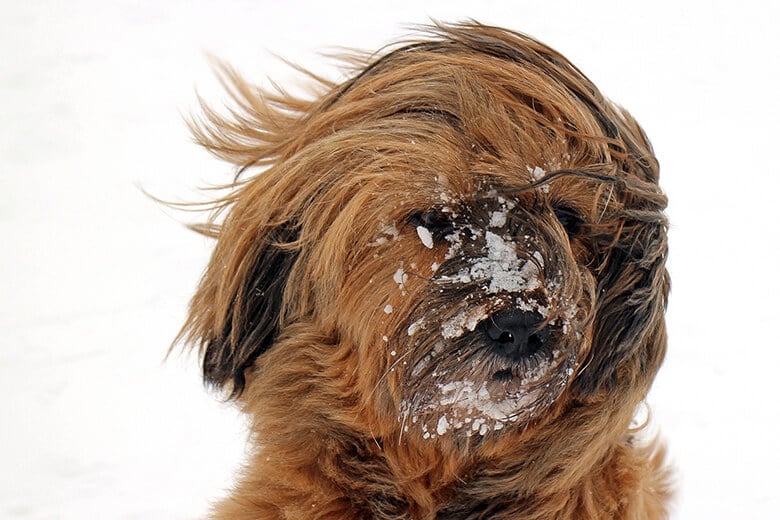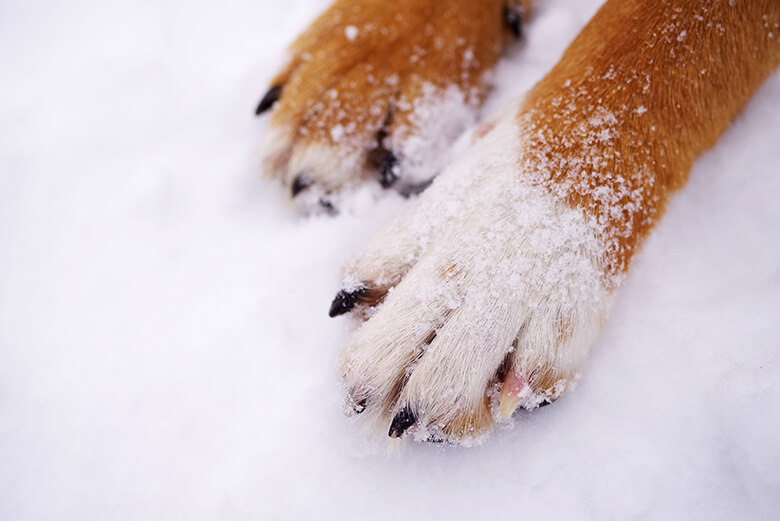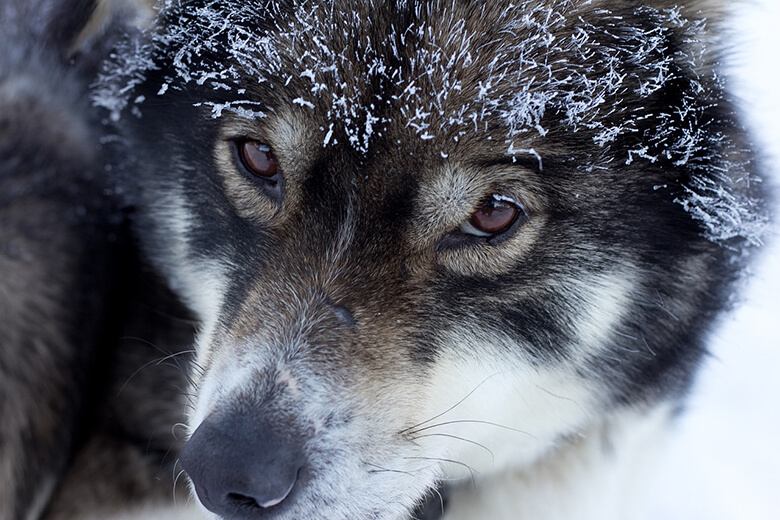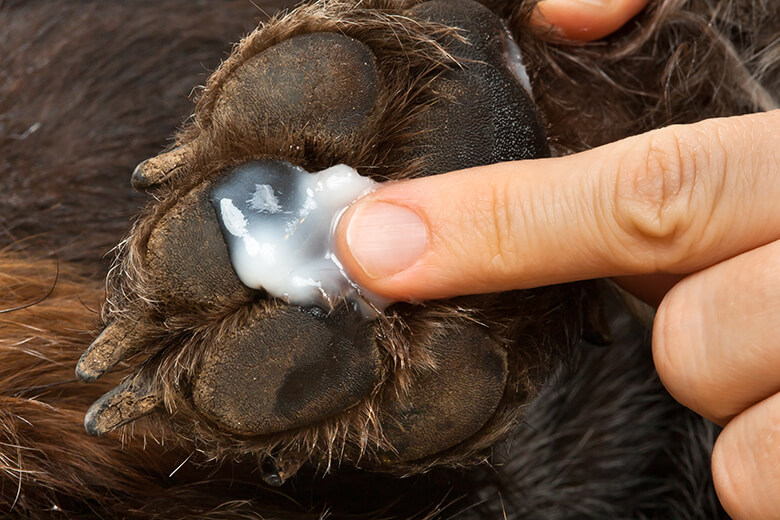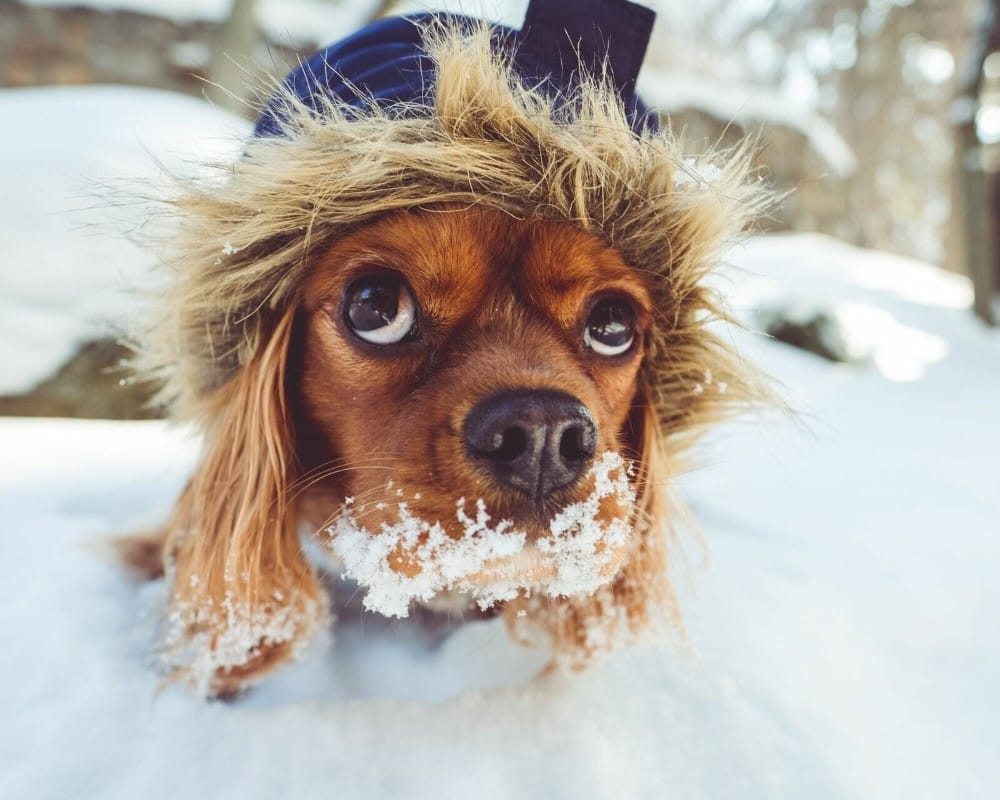While the paw pads of dogs might look (and feel) like they’re made for walking, sometimes freezing weather, rain, snow, salt and ice makes walking a real pain. Dogs paws and noses can become dry and the skin may crack. There are several reasons why this happens, but the bottom line is that cracked paws and nose hurt — a lot.
Cracked skin anywhere is painful, but it’s the paws (and the feet) that hold the body’s weight. This not only hurts, but it makes it much harder to heal.
The big problem lies in the fact that our pup can’t tell us their feet are dog tired (sorry, couldn’t resist). Dogs tend to hide pain; it’s instinctual. They do it to protect themselves and maintain their position in their pack (or how they perceive their position). In the wild, an injured animal is vulnerable to attack.
Related: How to Keep Your Dog Away From the Vet During the Winter
It’s up to use to notice. In very cold or very hot weather, examine your dog’s paws and nose frequently.
Signs your dog is in pain include:
- Limping
- Holding a paw up off the ground
- Shifting from leg to leg
- Panting
- Loss of appetite
- Crying out or yelping
- Snapping
- Becoming unnaturally quiet for a dog that is vocal or vocal for a dog that is normally quiet
- Rapid, shallow breathing
- Aggression
- Excessive licking of the paws
- Swiping at the nose with paws
- Trembling
Any of these symptoms can indicate your dog is in pain. If the symptoms are severe, take your dog to the veterinarian. If the symptom indicates his paws or nose are hurting, examine them closely. Make sure your dog hasn’t stepped on something sharp or that a foreign object isn’t embedded in their paws or stuck between the toes.
Sources that can cause your dog’s paws to crack:
Weather: Plain and simple, the dry winter air mixed with wet snow, can cause your dog’s paws and nose to get chapped.
Contact with an irritant. In the winter, watch out for products that melt snow and ice. Prolonged contact can cause chemical burns, and they can make your dog sick if ingested by licking. Other irritants include chemicals, household cleaners and fertilizer.
Prolonged exposure to ice, snow and burning or rough surfaces. This includes excessive running around on rocky surfaces, hot sand, hot or cold metal and snow melt products.
Allergies. Allergies can lead to cracked paws, especially food allergies. If your dog is biting at their paw or licking it excessively, he may be allergic to something.
Vitamin deficiencies. Some breeds are prone to zinc-responsive dermatosis. This condition causes cracked paws in any weather. Breeds to watch carefully include Alaskan breeds, particularly the Siberian Husky and Alaskan Malamute. Sometimes large breeds are also prone, including the German Shepherd, Great Dane, St. Bernard and Doberman.
Old age. Senior dogs may develop a condition called hyperkeratosis. It’s when the body produces too much keratin, which causes the skin and the paw pads to crack.
Related: The Must-Have Products to Keep Your Dog Safe and Warm During the Winter Season
Reasons your dog’s nose becomes dry, crusty or cracked:
Winter nose. It’s really a thing. Also called “snow nose,” it can be caused by cold, dry weather, both inside and outside. It can also be a symptom of aging. Some breeds are more susceptible to snow nose, including Labradors, some northern breeds like the Siberian Husky and Alaskan Malamute, Golden Retrievers, Afghan hounds and others.
Indoor heat. Warm air from radiators, electric heaters and central heating is incredibly drying to the skin. If your dog has been sleeping over a heating vent, he may wake up with a cracked or crusty nose.
Seasonal allergies. In the cold weather months, these allergies are usually due to indoor irritants. Dust mites and mold are top culprits.
Wet weather. The effects of freezing temperatures are increased if the skin is wet.
Dehydration. If your dog has sworn off the wet stuff, it’s possible she’s dehydrated. This affects the whole body. Keep your dog’s water bowl clean, and refresh their water frequently. Use stainless steel or ceramic bowls; plastic can be an irritant to dogs.
Natural Remedies to Alleviate Dry, Cracked Paws and Noses
The best medicine, of course, is prevention. Protect your dog’s paws with boots or socks that have gripper bottoms. If your dog isn’t having it, you can try PawZ rubber dog boots — they’re the easiest for your dog to get used to. Boots are particularly important if it snows and the streets are covered with salt. (If you’re the one throwing down the salt, use pet-safe snow melt products.)
If you just can’t deal with a dog wearing shoes, try Musher’s Secret Paw Protection Natural Dog Wax. Be sure to rub it between the paw pads to prevent “snowballing,” which is when snow attaches to a dog’s hair, melts from their body heat, and forms ice balls that grow larger, get stuck between the toes, stretching them apart and causing cracking, bleeding, and hair pulling. Musher’s can also be lightly dabbed on your pup’s nose to provide protection.
For our pup’s snouts, consider keeping it conditioned on a regular basis.
If you do find that your dog has cracked paws or the skin on her nose is dry, crusty or cracked, try these natural remedies:
Natural oils and butters. There are plenty of natural oils and butters that you can dab on paw pads and noses. Some of our favorites include coconut oil, shea butter, cupuacu butter and vitamin E oil. While these natural remedies definitely provide nourishment, they can be a little oily. If you can, cover your dog’s feet with socks to prevent her from licking it off.
Natural balms. There are many products for dogs that are made from safe, natural ingredients. Try Paw Soother, Paw Nectar or Dr. Harvey Organic Healing Dog Cream. For noses, try snout balm like Nature’s Kitchen or Snout Soother.
Hemp or CBD balms. If your dog is in pain, these balms will soothe and help heal cracks paws and noses while alleviating pain. Try Dr. Knows or King Kalm.
DIY Balms. Make your own balm from high-quality, natural ingredients. For a simple recipe, The Homestead Survival uses just 5 ingredients: olive oil, coconut oil, Vitamin E oil, shea butter and beeswax.
Related: When Taking Your Dog for a Walk, Beware of These Hazards













